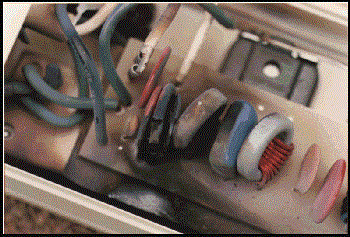From February 1994 to February 1995, two families on Brainbridge Island lost their homes due to fires caused by Multiple Outlet Power Surge Suppressors! Failing devices have also been discovered on campus (see photo), luckily before there was a fire.
Do not confuse surge suppressor strips with the general purpose multiple outlet power strips. The surge suppressor strip contains a Metal Oxide Varistor (MOV) designed to limit power current surges or “spikes” that can damage electronic equipment. The Varistor traps the over-the limit part of the current surge and dissipates it as heat. All MOVs gradually deteriorate with use.
The problem found with some MOV components is that over a 18 to 24 month period the materials used begin to break down. As the MOV ages, its operating characteristics change and it can become more sensitive and dissipate more heat. If the case is made of plastic, this process could eventually cause the plastic to discolor, melt, flow, and ignite. The plastic burns fiercely, resists extinguishment, and produces fumes that are extremely toxic. Early signs of failure include discoloration on the underside and top due to heat buildup (see photos).


The culprits are “low cost,” multiple outlet surge suppressors with cases made of plastic and manufactured or assembled in China. These units are commonly sold at discount stores, in packages of two or more, and are U.L. listed.
It should also be noted that other strips have been known to fail due to the excess demand placed on them. Most surge suppressor plug strips are designed for personal computers and peripherals that draw 2 to 8 amps. However, many are incorrectly used as extension cords for small appliances such as space heaters (which draw 12 amps or more), TVs, lamps, copy and fax machines, phone answering systems, etc.
If you find a failing device, throw it out immediately and replace it with a quality unit fabricated with a metal case (if possible). Quality units will have a warning indicator and/or an internal shut down mechanism if the MOV is failing.
( Reprinted from: University of Washington, Environmental Health and Safety)




